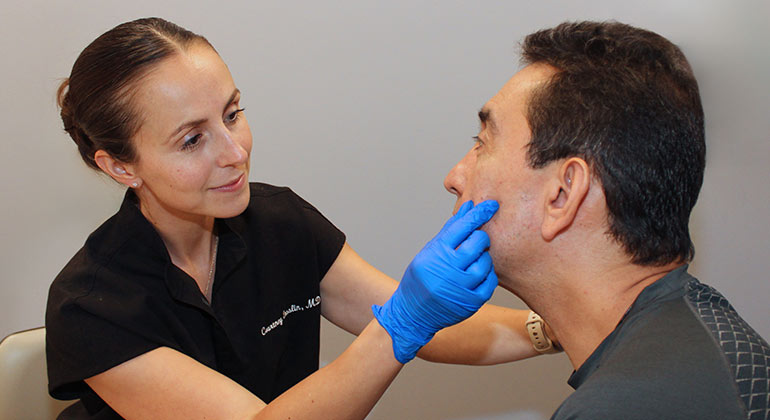Frequently Asked Questions

Mohs surgery is the most effective treatment for most types of skin cancer. We have provided answers to several common questions about Mohs skin cancer surgery below.
Why is it called Mohs surgery? Is Mohs an acronym?
The term "Mohs" refers to Dr. Frederic Mohs, Professor of Surgery at the University of Wisconsin, who developed this surgical technique in the 1930s. The technique has undergone many refinements since.
What is Mohs surgery?
Dr. Mohs recognized that a skin cancer often resembles the "tip of the iceberg" with more tumor cells growing downward and outward into the skin like the roots of a tree. These "roots" are not visible with the naked eye, but can be seen under a microscope.
Mohs surgery is a highly specialized and precise treatment for skin cancer in which the cancer is removed in stages, one tissue layer at a time. It is an outpatient procedure, performed under local anesthesia, and is distinguished by a specific technique of tissue examination that is unique to Mohs surgery. Although other surgical specialists may check excision margins, this form of pathologic examination of the tissue is not the same as Mohs surgery.
Once a tissue layer is removed, its edges are marked with colored dyes, and a map of the specimen is created. The tissue is then processed onto microscope slides by a Mohs histotechnician. These slides are carefully examined under the microscope so that any microscopic roots of the cancer can be precisely identified and mapped. If cancer cells are seen, an additional tissue layer is removed only in areas where the cancer is still present, leaving normal skin intact. This saves as much normal, healthy skin as possible.
Once the cancer has been removed, the Mohs surgeon will explain options for repair of the wound, including natural healing (granulation), stitching the wound together using a side-to-side closure, or using a skin flap or graft.
I don't see anything after my biopsy. Do I really need to be treated?
Yes. Following a biopsy, your skin cancer may no longer be visible. However, the surface lesion that was removed can represent the "tip of the iceberg." There may be more tumor cells in the skin. These can continue to grow downward and outward, like roots of a tree. These "roots" are not visible with the naked eye. If they are not removed, the tumor will likely reappear and require more extensive surgery. On rare occasions, these cancerous cells can spread (metastasize) to lymph nodes and other organs in the body.
Why does my skin cancer need to have Mohs surgery?
Mohs surgery has the highest cure rate. It is appropriate for most skin cancers and especially suitable for skin cancer that:
- Is in an area where it is important to preserve healthy tissue for maximum functional and cosmetic result
- Was treated previously and has come back
- Is located near scar tissue
- Is large
- Does not have clearly defined edges
- Is growing rapidly or uncontrollably
- Is of an aggressive subtype (i.e., sclerosing or infiltrating basal cell carcinoma)
- Develops in organ transplant or lymphoma patients
Please note: The above list is not exhaustive of all of the instances where Mohs surgery is the most appropriate option for your skin cancer.
How long does Mohs surgery take?
The length of surgery is different for every patient and is difficult to estimate prior to the actual procedure. It depends on the extent of the tumor, which we do not know until we start removing it. Although Mohs surgery can take longer than other approaches, advances in technology, such as automated staining of tissue samples, have made it quicker. Typically, the entire procedure lasts several hours. Your Mohs surgeon may be able to give you a clearer sense of the timeframe you can expect
Will Mohs surgery leave a scar?
Yes. Mohs surgery will leave a scar, like any other surgical treatment for skin cancer.
Mohs surgery preserves as much healthy skin as possible and maximizes options for repairing the surgical defect, once the tumor is completely removed. Once the Mohs surgeon has completely removed your skin cancer through Mohs surgery, reconstruction that optimizes the final functional and cosmetic result becomes the highest priority. Generally, a post-surgical scar improves with time and can take up to one year or more to fully mature. As your surgical site heals, new blood vessels can appear and support the healing changes occurring underneath the skin. This can result in a reddish appearance of the scar. This change is temporary and will improve with time.
In addition, the normal healing process involves a period of skin contraction, which often peaks four to six weeks after the surgery. This may appear as a bumpiness or hardening of the scar. On the face, this change is nearly always temporary and the scar will soften and improve with time. If you have a history of abnormal scarring, such as hypertrophic scars or keloids, or if there are problems with the healing of your scar, we may use injections or other treatments to achieve the best possible cosmetic result. Your Mohs surgeon is available for you throughout the healing process to discuss any concerns that may arise.
Is Mohs surgery the most cost-effective treatment option?
Because of Mohs surgery's high success rate, most patients require only a single surgery. This surgery usually includes the repair of the wound as well. Other methods might require additional surgeries and pathology readings in order to repair the wound and to treat the cancer if it is not completely removed. Each of these additional surgeries and pathology readings require separate fees, while a single Mohs surgery procedure includes all of these into one fee.